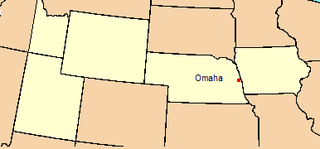
This section of the timeline of United States history concerns events from 1860 to 1899.

The territory of the United States and its overseas possessions has evolved over time, from the colonial era to the present day. It includes formally organized territories, proposed and failed states, unrecognized breakaway states, international and interstate purchases, cessions, and land grants, and historical military departments and administrative districts. The last section lists informal regions from American vernacular geography known by popular nicknames and linked by geographical, cultural, or economic similarities, some of which are still in use today.

John McAllister Schofield was an American soldier who held major commands during the American Civil War. He was appointed U.S. Secretary of War (1868–1869) under President Andrew Johnson and later served as Commanding General of the United States Army (1888–1895).

Fort Larned National Historic Site preserves Fort Larned which operated from 1859 to 1878. It is approximately 5.5 miles (8.9 km) west of Larned, Kansas, United States.
The Department of the Pacific or Pacific Department was a major command (Department) of the United States Army from 1853 to 1858. It replaced the Pacific Division, and was itself replaced by the Department of California and the Department of Oregon.

The Department of the Platte was a military administrative district established by the U.S. Army on March 5, 1866, with boundaries encompassing Iowa, Nebraska, Dakota Territory, Utah Territory and a small portion of Idaho. With headquarters in Omaha, the district commander oversaw the army's role initially along the Overland route to Salt Lake City, then later the construction route of the Union Pacific Railroad. The district also included the Montana road through eastern Wyoming. The district was discontinued when the Army's command was reorganized in 1898.
A subdivision of the Division of the Missouri, the Department of Dakota was established by the United States Army on August 11, 1866, to encompass all military activities and forts within Minnesota, Dakota Territory and Montana Territory. The Department of Dakota was initially headquartered at Fort Snelling, Minnesota, and then moved to Saint Paul in March 1867. The 18th Infantry Regiment would serve in Dakota several times. From 1869-1877 the 20th Infantry Regiment was posted to the Department. In 1879 the Department returned to the Fort until 1886 at which time it moved back to downtown Saint Paul. The department was discontinued in 1911.
The 1st Kansas Infantry Regiment was an infantry regiment that served in the Union Army during the American Civil War. On August 10, 1861, at the Battle of Wilson's Creek, Missouri, the regiment suffered 106 soldiers killed in action or mortally wounded, one of the highest numbers of fatalities suffered by any Union infantry regiment in a single engagement during the American Civil War.
The 8th Kansas Infantry Regiment was an infantry regiment that served in the Union Army during the American Civil War.
The 11th Kansas Volunteer Cavalry Regiment was a cavalry regiment that served in the Union Army during the American Civil War.

The District of Oregon was a Union Army command department formed during the American Civil War.
During the American Civil War in the early 1860s, the District of Utah was a subordinate district of the U.S. Army's Department of the Pacific. The district was composed of territorial areas that later became parts of the modern U.S. states of Idaho, Nevada, and Utah.
District of Arizona was a subordinate district of the Department of New Mexico territory created on August 30, 1862 and transferred to the Department of the Pacific in March 1865.

Clarence Edmund Bennett (1833–1902), usually referred to as Clarence E. Bennett, a graduate of West Point, a career American Army officer who saw duty almost exclusively in Western frontier assignments, served in the American Civil War in California, New Mexico and Arizona Territories and later in Reconstruction occupation forces and frontier duty during the later Indian Wars.
The Department of the Columbia was a major command (Department) of the United States Army during the 19th century.
The Military Division of the Missouri was an administrative formation of the United States Army that functioned through the end of the American Civil War and the Indian Wars that continued after its conclusion. It was created by the War Department on February 3, 1865, at the direction of General Ulysses S. Grant to bring all the military departments west of the Mississippi River under a single commander.
The Department of the Northwest was an U.S. Army Department created on September 6, 1862, to put down the Sioux uprising in Minnesota. Major General John Pope was made commander of the Department. At the end of the Civil War the Department was redesignated the Department of Dakota.
During the American Civil War, a department was a geographical command within the Union's military organization, usually reporting directly to the War Department. Many of the Union's departments were named after rivers or other bodies of water, such as the Department of the Potomac and the Department of the Tennessee. The geographical boundaries of such departments changed frequently, as did their names. As the armies became larger Departments began to be subordinated to Military Divisions, and the Departments were often sub divided into Districts and from 1862 Subdistricts. Much information on Civil War departments can be found in Eicher & Eicher, Civil War High Commands.
The District of New Mexico was a military district of the United States Army in the Territory of New Mexico that existed from 1865 to 1890. The District of Arizona and the District of New Mexico replaced the Department of New Mexico from June 27, 1865.

Henry Erastus Noyes was a United States Army Officer who served during the American Civil War, American Indian Wars and Spanish–American War.








